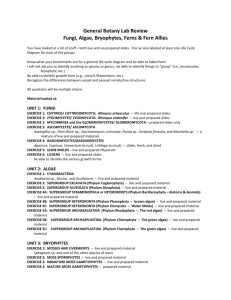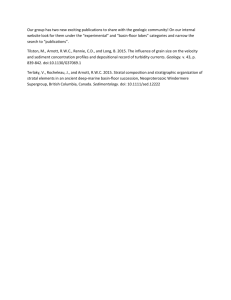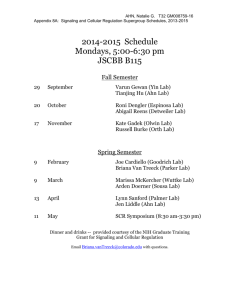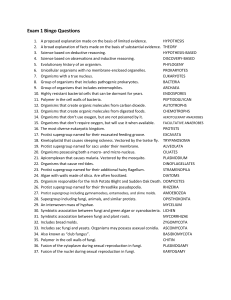Protists
advertisement
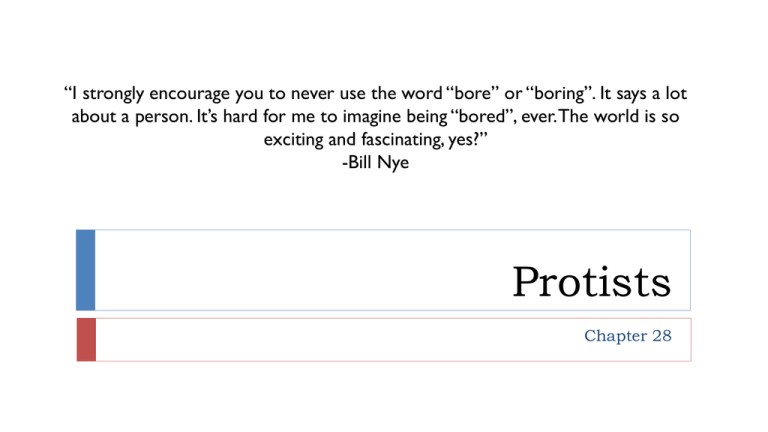
“I strongly encourage you to never use the word “bore” or “boring”. It says a lot about a person. It’s hard for me to imagine being “bored”, ever. The world is so exciting and fascinating, yes?” -Bill Nye Protists Chapter 28 “Protista” Characteristics Eukaryotic organisms that are not plants, animals, or fungi Most are unicellular Without _________ First eukaryotes arose ~1.5 bya Protists: similar appearing but diverse phyla that are not related through an exclusive common ancestor, which have different life cycles, trophic levels, modes of locomotion and cellular structures. *Cluster______ that is under constant debate and revision Four Supergroups: Excavata SAR (Stramenopiles, Alveolata, Rhizaria) Archaeplastida Includes land plants Unikonta Includes animals and fungi *Need to know entire phylogeny for test and practicum Eukaryotic Cells Animal cell Plant cell Single Celled Protists Paramecium Euglena Anterior pocket Modes of Locomotion Evolution of Eukaryotes Autogenesis: ________ of prokaryote plasma membranes lead to compartmentalization Endoplasmic reticulum Golgi Nuclear membrane Evolution of Eukaryotes ______________: one organism lives inside the cell or cells of the other organism Mitochondria Plastid: double membrane organelle in plants and algae Chloroplast Supergroup: Excavata Characteristics of Excavata: “Excavated” groove on side of cell body (some) Free living, symbiotic and parasitic forms Reduced or modified mitochondria Multiple flagella Similar cytoskeleton elements (Simpson 2003) Simpson, A.G.B. 2003. Cytoskeletal organization, phylogenetic affinities and systematics in the contentious taxon Excavata (Eukaryota). International Journal of Systematic and Evolutionary Microbiology. 53, 1759-1777 Supergroup: Excavata Clade: Diplomonads Example: Giardia lamblia Two equal sized, haploid nuclei Four flagella Reduced mitochondria ___________ Internal parasite to vertebrates Giardiasis infection from drinking contaminated water Lab photo Supergroup: Excavata Clade: Parabasalids Example: Trichomonas vaginalis Multiple flagella _________ membrane Reduced mitochondria ________________ Sexually transmitted disease Vaginitis infection from skin to skin contact with infected person Lab photo Supergroup: Excavata Clade1: Euglenazoans; Clade2: Euglenids Example: Euglena sp. Crystalline or spiral rod inside of flagella (all Euglenazoans) __________: photosynthesize when light is present, heterotrophic when its not Flagella emerge from anterior pocket Lab photo Supergroup: Excavata Clade1: Euglenazoans; Clade2: Kinetoplastids Example: Trypanosoma sp. Crystalline or spiral rod inside of flagella (all Euglenazoans) __________: Single, large mitochondrion African sleeping sickness from tsetse fly Chagas’ disease from mosquitos Lab photo Supergroup: SAR SAR Starmenopila Alveolata Rizaria Characteristics of SAR: Secondary endosymbiosis of red algae Similar DNA sequences Supergroup: SAR Clade1: Stramenopila Characteristics of Stramenopila: One hairy and one smooth flagella (most Stramenopiles) Stramen = straw; pilos = hair Includes: Oomycetes (water molds) Diatoms Golden algae (Chyrsophyta) Brown algae Supergroup: SAR Clade1: Stramenopila; Clade2: Oomycota Example: water molds Cellulose cell wall __________ hyphae Heterotrophic decomposers Some parasitic Loss of plastids Caused __________and French Wine Crisis Supergroup: SAR Clade1: Stramenopila; Clade2: Diatoms Example: Diatoms Unicellular algae _____ cell wall Important photosynthetic organisms Fossilized diatoms form diatomaceous earth Lab photo Diatoms in the Food Web Supergroup: SAR Clade1: Stramenopila; Clade2: Chyrsophyta Example: Golden Algae Yellow and brown carotenoids ____________ Bi-flagellated cells Many planktonic Some are mixotrophic Most unicellular, some colonial Lab photo Supergroup: SAR Clade1: Stramenopila; Clade2: Brown Algae Example: Brown algae Multicellular Most marine (temperate coasts) Brown and yellow carotenoids ____________ Algin Alteration of Generations Alteration between multicellular haploid (n) and diploid (2n) forms Sporophyte: Diploid life form that produces spores Gametophyte: Haploid life form that produces gametes (egg and sperm) Supergroup: SAR Clade1: Alveolata Characteristics of Alveolata: Membrane bound sacs (alveoli) DNA similarities Includes: Dinoflagellates Apicomplexans Ciliates Supergroup: SAR Clade1: Alveolata; Clade2: Dinoflagellates Example: Dinoflagellates Reinforced cellular plates Move via flagella Flagella in grooves Cause _________ Lab photo Supergroup: SAR Clade1: Alveolata; Clade2: Apicomplexans Example: Plasmodium sp. Animal parasities Sporozoites: infectious cells _______ structure Cause malaria Mosquito Plasmodium Lab photo Mosquito Supergroup: SAR Clade1: Alveolata; Clade2: Ciliates Examples: Paramecium sp.,Vorticella sp. Most are predatory Two types of nuclei Spirostomum Micronuclei and Macronuclei ____________: exchange of micronuclei without reproduction Binary fission: asexual reproduction Lab photo Vorticella Lab photo Supergroup: SAR Clade1: Rhizaria Characteristics of Rhizaria: Amoebas Thread-like __________ DNA similarities Includes: Foraminiferans Cercozoans Radiolarians Supergroup: SAR Clade1: Rhizaria; Clade2: Foraminiferans Examples: Foraminiferans Porous, _____________ tests Foramen (little hole), ferre (to bear) Marine and freshwater Fossilized forams = sedimentary rock Lab photo Supergroup: SAR Clade1: Rhizaria; Clade2: Cercozoans Examples: Cercozoans Thin pseudopodia _____________: photosynthetic structure Marine, freshwater and soil Lab photo Supergroup: SAR Clade1: Rhizaria; Clade2: Radiolarians Examples: Radiolarians Silica tests Pseudopodia reinforced with microtubules Mostly marine ________________ Lab photo Lab photo Supergroup: Archaeplastida Characteristics of Archaeplastida: Similar DNA sequences Endosymbiosis of cyanobacterium Includes: Red algae Chlorophytes Charophytes Land plants Supergroup: Archaeplastida Clade1: Red algae Examples: Chondrus, Coralline Multicellular Cellulose cell wall _______________: photosynthetic pigment Chondrus Blue and green wavelengths Mostly marine (warm tropical) Agar Lack flagellated gametes Coralline Lab photo Supergroup: Archaeplastida Clade1: Chlorophytes Example: Ulva Unicellular, Multicellular, and Colonial Cellulose cell wall Pigments Ulva ______________ Carotenoids Mostly freshwater Lab photo Supergroup: Archaeplastida Clade1: Charophytes Examples: Volvox, Spirogyra Volvox Sister taxa of land plants Cellulose cell wall Pigments Rings of cellulose synthesizing proteins Peroxisome enzymes Structure of flagellated sperm Formation of ____________ Chlorophyll A, B Carotenoids Mostly freshwater Spirogyra Lab photo Supergroup: Unikonta Characteristics of Unikonta: Two major subgroups (Amoebazoans and Opisthokonts) Within group relationships support with DNA sequencing May have been first group to diverge from eukaryotes Single flagella Lobe or tube shaped pseudopodia Fusion of three genes Supergroup: Unikonta Clade1: Amoebazoans Characteristics of Amoebazoans: _________________ pseudopod used for movement and feeding Includes: Slime molds Plasmodial Cellular Gymnaoembas Entamoebas Supergroup: Unikonta Clade1: Amoebazoans; Clade2: Slime molds Example: Plasmodial slime molds Many are brightly colored _____________: Single mass of cytoplasm Supercell Single celled with multiple nuclei Coenocytic hyphae Supergroup: Unikonta Clade1: Amoebazoans; Clade2: Slime molds Example: Cellular slime molds Solitary feeding stage Form asexual fruiting bodies when food stressed _________ hyphae Supergroup: Unikonta Clade1: Amoebazoans; Clade2: Gymnamoebas Example: Tubulinids (Gymnamoebas) Lobe or tube-shaped pseudopodia ____________ streaming Lack of test Unicellular Mostly heterotrophic Marine, freshwater, and soil Supergroup: Unikonta Clade1: Amoebazoans; Clade2: Entamoebas Example: Entamoeba histolytica _________ Amoebic dysentery Contaminated drinking water or food Lab photo Supergroup: Unikonta Clade1: Opisthokonts Characteristics of Opisthokonts: Unicellular or multicellular Posterior location of flagellum Includes: Nucleariids Fungi Choanoflagellates Animals Supergroup: Unikonta Clade1: Opisthokonts; Clade2: Nucleariids Example: Nucleariids Lack distinctive characteristics Unicellular Posterior flagella Temporary pseudopods Feed on algae and bacteria Closely related to fungi Supergroup: Unikonta Clade1: Opisthokonts; Clade2: Choanoflagellates Example: Choanoflagellates Unicellular or colonial ___________ feeders Closest relative to animals
